Bezpłatne konsultacje
Zadzwoń do nas: 0333 0384 103
Przeglądaj według kategorii




Najnowsze studia przypadków


Przeglądaj według kategorii



Najnowsze studia przypadków


Przeglądaj według kategorii







Najnowsze studia przypadków


Przewodniki kupowania


Blog - Centrum Badań i Innowacji
Przeglądaj według kategorii



Najnowsze artykuły


Przeglądaj według kategorii







Najnowsze wiadomości



Przeglądaj według kategorii




Najnowsze studia przypadków


Przeglądaj według kategorii



Najnowsze studia przypadków


Przeglądaj według kategorii







Najnowsze studia przypadków


Przewodniki kupowania


Blog - Centrum Badań i Innowacji
Przeglądaj według kategorii



Najnowsze artykuły


Przeglądaj według kategorii







Najnowsze wiadomości





W każdym jeziorze, stawie lub zbiorniku, bez względu na wielkość, ważne jest, aby mieć wystarczający poziom rozpuszczonego tlenu (DO). Tlen rozpuszczony jest zwykle mierzony w częściach na milion (PPM). Minimalny poziom rozpuszczonego tlenu, do którego powinieneś dążyć, wynosi od 4 do 5 PPM. Mimo to ideał wynosi około 8-9 PPM.
Jeśli ilość rozpuszczanego tlenu w jeziorze lub zbiorniku jest niższa niż 4-5 PPM, twoje ryby w zbiorniku wodnym mogą umrzeć z większą ilością uduszenia. Strategy, warstwa wody z niedoborem tlenu na dnie stawu lub jeziora, jest kolejnym możliwym efektem ubocznym niskiego poziomu tlenu. Może to spowodować obumieranie życia roślin w stawie lub jeziorze. Jeśli martwe życie roślinne nie jest używane, zgnij. Ten muł i nagromadzenie poziom azotanów i azotanów To ostatni wpływ na gromadzenie amoniaku. Zawdzięczamy również atmosferę atmosfery w oleju odpadów.

Duże ilości glonów i roślin wodnych są warzywami winowajcami, ponieważ jest dużo złota po upływie roku. Wysoki poziom oleju z oleju języka lub stawie, aby być wodą. Wreszcie posiadanie zbyt dużej ilości ryb w stawie lub jeziorze może obniżyć poziom tlenu. Dotyczy to nie tylko oleju z oleju, ale piwo ma również materiały produktowe odpadów.
W naturalnym, ekologicznie uzasadnionym jeziorze wymagana jest napowietrzania. Dodatkowa presja wywierana na wiele jezior i zbiorników wodnych, a także wiosną i latem, oznacza, że dodatkowa napowietrzanie jest niezbędnym narzędziem zarządzania dla jezior, jezior i stawek.
Zbiornik wodny o zdrowej równorzędze ekologicznej jest silnie zależny od tlenu. To stada ryb, bakterie mikroskopijne są wykorzystywane do usuwania odpadów organicznych, utleniania mułu, wydzielania gazów lub składników odżywczych oraz innych substancji.
Pomożemy Ci zwiększyć poziom rozpuszczonego tlenu dzięki naszemu naszemu naszemu rozproszony aerator zasięg
Przeczytaj nasze artykuły z poradami na stronie internetowej lub na LinkedIn

Czasami brak dostępnej mocy oznacza, że wymagany jest specjalistyczny system napowietrzania, a wraz ze wzrostem kosztów energii nie ma lepszej opcji niż zasilany energią słoneczną podpowierzchniowy system napowietrzania, który pomoże obniżyć miesięczne koszty energii.

Nękane przez brzydkie glony powodujące zieloną wodę z grochu i niepożądane zapachy, jezioro Longleat Forest desperacko potrzebowało natlenionej wody i mieliśmy odpowiedni system napowietrzania wody, aby to zapewnić. Nasz wyprodukowany we własnym zakresie rozproszony OxiAir HD®...
Przeczytaj cały artykuł
Napowietrzanie ścieków jest kluczowym procesem w oczyszczaniu zanieczyszczonej wody, w którym powietrze jest celowo wprowadzane do ścieków w celu ułatwienia wzrostu i aktywności mikroorganizmów tlenowych. Ta metoda wykorzystuje moc tlenu, aby wspierać metabolizm...
Przeczytaj cały artykuł
Duże fontanny do jezior są popularną cechą, która dodaje estetyki i poprawia wrażenia wizualne jeziora. Te fontanny są zaprojektowane tak, aby tworzyć imponujące wyświetlacze strumieni wody, wzorów, a czasem zsynchronizowanych efektów świetlnych.

Fontanny i aeratory Heathland skontaktował się z klientem krajowym w Essex w celu uzyskania wyceny w maju 2019 r. Klient ma jezioro na swojej posesji, gdzie potrzebował pływającej fontanny jeziornej do napowietrzania. Oświetlenie fontanny, aby stworzyć oszałamiającą wieczorną ekspozycję ogrodu, również stanowiło część raportu klienta.

W Heathland Group oferujemy dwa rodzaje napowietrzania jeziora, napowietrzanie rozproszone i napowietrzanie pływające, aby pomóc Ci skutecznie napowietrzać jezioro. Rozproszony aerator pompuje powietrze przez membrany dyfuzora, które następnie przemieszcza się na powierzchnię w postaci milionów drobnych pęcherzyków...

